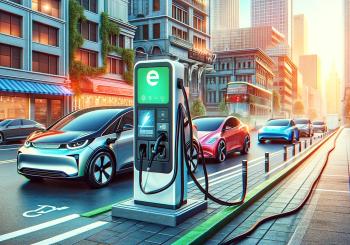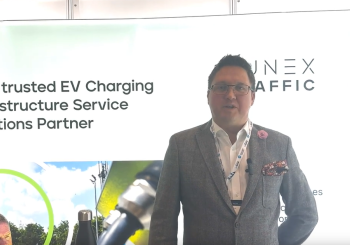“There is definitely widespread confusion,” says Kelley, director of energy solutions at XCharge North America.
Failing to understand the differences could have a significant negative impact on the EV charging industry, he believes.
Many EV charging businesses perceive two options that accomplish the same thing, but one is inexpensive (buffered) and the other more costly (integrated).
Kelley sees things much differently. Buffered solutions are less costly because they do not require significant hardware upgrades at EV charging stations. The systems take in electricity (from the grid) and provide some management, such as peak demand reduction and load shifting.
However, buffering is a one-way street. Power comes in (and is managed) but does not go out. Buffering cannot return power to the grid.
Battery-integrated solutions offer more advanced energy management options. They can actually store power and transmit it at a later time – for example, when rates are high.
Integrated solutions can return power to the grid – and benefit financially from doing so.
The problem, Kelley says, it that EV charging businesses are mistakenly choosing buffered solutions with the belief they will be able to sell power back to the grid. These businesses are counting on a revenue stream that won’t be available.
The confusion will cause the electric grid to suffer, too. “Rather than sticking a bandage on America’s weak electric infrastructure, battery-integrated chargers offer a true cure,” Kelley states.

Kelley recently answered a few questions to help clarify the differences.
Q: Why would a business choose an integrated solution over a buffered solution?
A: The most basic difference between the two is that battery integration takes technological steps beyond what buffered can offer. This is so important because it unlocks a multitude of additional functionality and revenue streams for the equipment owner and operator.
Additionally, the battery integrated system also can provide valuable resources to the grid, via bidirectional charging and V2G (vehicle to grid). Both systems offer the same benefits to the owner/operator by allowing sites to offer DCFC without the need for infrastructure upgrades – and without significant increases to demand charges.
Q. Is there widespread confusion between the two in the EV industry?
A. There is definitely widespread confusion, especially because the majority of solutions available and in development are battery-buffered. The language is so similar sounding, it would be impossible for misconceptions to not happen.
XCHARGE North America sees the value in true bidirectional charging, and partnering with various grid operators, to help these entities manage the transitional changes required to change from ICE to EVs.
Q. What will be the impact of the confusion?
We have disconnects between auto manufacturers, federal and state governments, and the EV charging space. The automotive industry and governments tout the importance of V2G and bidirectional charging, and they are building programs and incentives to encourage that.
Ramifications include misunderstanding what your equipment and sites can do, developers misquoting economic benefits, and missing out on incentives.
Q. So they offer incentives that EV businesses believe they can earn, only to discover they’ve acquired the wrong solution?
A. Yes. Buyers and project developers have to be careful to evaluate the capabilities of the equipment they spec and select.
Let’s say their model includes rate arbitrage, demand response or ancillary grid services. They need to make sure these are possible with their equipment. If they aren’t, they will miss out on multiple revenue streams.
Q. What is the impact on the grid?
Buffered does not allow for bidirectional charging back to the grid, and from vehicle to grid. If we proceed with only buffered solutions, or if that becomes the primary offering in the marketplace, we are missing out on this opportunity to provide valuable and necessary resources to the grid.
We need to work in tandem with grid operators, utilities, ISOs, etc., and utilize the benefits of battery storage to everyone’s advantage. We have to minimize the amount of strain we put onto the grid as the industry grows rapidly.
We want to offer EV car and truck owners – and EV charging site owners – competitive pricing, utility rates, tariffs and valuable incentives.
Q: Will the utilities take some kind of action if the EV industry doesn’t help support the grid?
A: We can either work as a strain to the system, and expect to get regulated and tariffed into dangerous territory, or we can work with these bodies on something mutually beneficial.
Q: Could this have a significant impact on adoption?
A: If not remedied, this will likely put the EV industry in a position that solar currently faces. Look at all the misconceptions solar system owners have about what their equipment can and can’t do – during blackouts, for example.
(Solar) regulators, grid operators and utilities saw radical changes to energy transmission and usage needs – as well as declining revenue – while they were expected to maintain expensive infrastructure. As a result, they behaved exactly as we expected. They (grid operators) seek profitability.
You can expect the same to happen here.
Q: I’m sure there are many issues beyond returning power. Can you explain some?
In the longer term, going to market without offering grid services puts the industry in the position of takers that need resources, rather than participants that can use creative solutions to mitigate strain.
Partnering now with utilities gives us more room to influence and negotiate mutually beneficial rates, tariffs, programs, and incentives – now and in the future.





Follow Us On Social Media